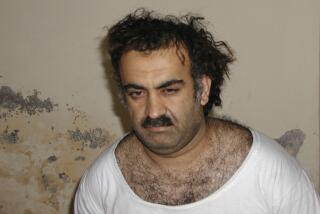Pentagon to seek death in Cole blast
- Share via
MIAMI — The Pentagon announced Monday it would seek the death penalty against a Saudi Arabian accused of plotting the October 2000 terrorist attack on the destroyer Cole that killed 17 U.S. sailors.
Abd al Rahim al Nashiri, whom officials allege was the Al Qaeda chief for the Arabian Peninsula before his capture in 2002, faces charges of murder, conspiracy, treachery and five other terrorism-related acts if the proposed capital case is approved by the civilian head of the Guantanamo Bay war crimes tribunal.
Nashiri was one of three terrorism suspects subjected to the controversial interrogation tactic known as waterboarding while in secret CIA custody abroad, CIA Director Michael V. Hayden told Congress in February.
The procedure simulates drowning and has been deemed torture by human rights advocates and most U.S. allies. Military interrogators and FBI agents have renounced its use.
Nashiri, a Saudi of Yemeni descent, was among 14 so-called high-value detainees moved from secret CIA prisons to the detention facility at the U.S. Naval Base at Guantanamo Bay, Cuba, in September 2006.
At his Combatant Status Review Tribunal six months later, a court-mandated intake procedure for each prisoner after his arrival at Guantanamo, Nashiri said that while in CIA custody he was tortured into confessing to the Cole bombing and other acts of terrorism.
Evidence submitted to the March 2007 review also linked Nashiri to the U.S. Embassy bombings in East Africa in 1998 that killed at least 224 people. He was also said to have plotted the October 2002 attack on the French supertanker Limburg in which a crew member was killed and 90,000 barrels of oil spilled into the Gulf of Aden.
Air Force Brig. Gen. Thomas W. Hartmann, legal advisor to tribunal Convening Authority Susan J. Crawford, was asked at a Pentagon news conference on Monday how the government expected to convict Nashiri on evidence that would be inadmissible in any other U.S. court. Hartmann said all evidence, including the allegations of torture, would be addressed by the tribunal.
Hartmann has spearheaded a drive by the tribunal to get high-profile cases under way before the November elections. The advisor was disqualified in May from one war crimes case after a judge ruled he lacked “independence from the prosecutor function.”
Nashiri would become the sixth Guantanamo prisoner facing the death penalty if Crawford approves the charges drafted by prosecutors. He is the 20th Guantanamo prisoner to be identified for prosecution from among the 270 still detained there. The government has said it plans to bring charges against as many as 80.
Calls for Guantanamo’s closure have escalated after three Supreme Court rulings accorded the foreign prisoners rights the military had argued didn’t apply to them because they weren’t held on U.S. soil. A June 12 high court ruling held that the terrorism suspects had the right to challenge their detention in U.S. federal courts -- an action that is expected to result in the transfer or release of dozens of prisoners.
Anthony D. Romero, executive director of the American Civil Liberties Union, said the ACLU would provide an experienced civilian defense attorney for Nashiri to augment what he called “under-resourced military defense teams” for defendants threatened with execution. “No matter how hard the Bush administration pushes in its waning days, our defense team is committed to doing everything possible to ensure that this case does not become a political show trial where prosecutions and convictions happen in the blink of an eye without regard for due process, the rules of evidence and the U.S. Constitution,” he said.
In New York, U.N. human rights special envoy Philip Alston deemed the Guantanamo tribunal flawed for the restricted rights accorded detainees and rules that allowed coerced evidence and hearsay.
“It would violate international law to execute someone following this kind of proceeding,” Alston said at the end of a two-week U.S. visit.
The Pentagon charge sheet on Nashiri alleges that he joined Al Qaeda in 1998 and rented a residence in Aden, Yemen, where the Cole attack occurred two years later. He is said to have procured the boat and explosives used to attack the Cole. The same vessel was used nine months earlier, in January 2000, in a failed attempt to blow up another U.S. Navy vessel, The Sullivans.
He was arrested two years after the Cole bombing in the United Arab Emirates. The CIA hasn’t disclosed where it held him for the four years between his capture and his transfer to Guantanamo along with 13 others, including confessed Sept. 11 mastermind Khalid Shaikh Mohammed.
Mohammed and four others accused of plotting the U.S. attacks also face the death penalty if convicted on murder and conspiracy charges.
--
More to Read
Sign up for Essential California
The most important California stories and recommendations in your inbox every morning.
You may occasionally receive promotional content from the Los Angeles Times.














